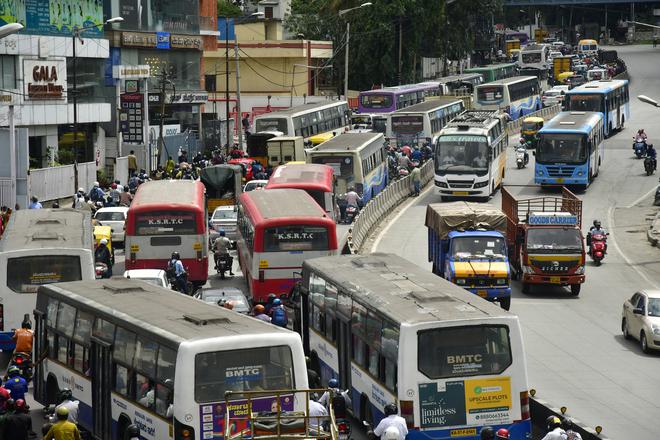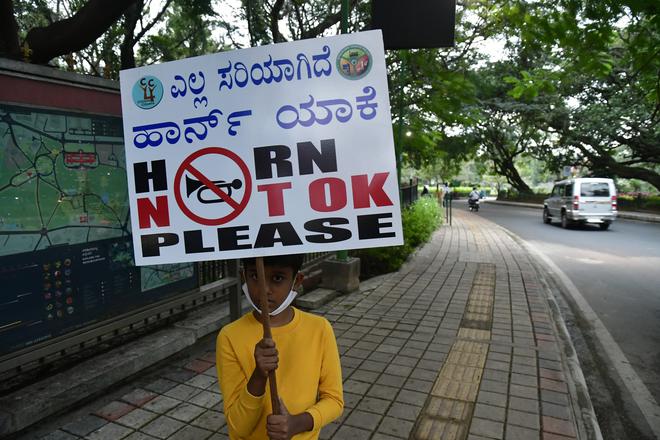Driven by ceaseless, rampaging road traffic growth, vehicular noise pollution has hit pandemic proportions in Bengaluru. Yet, despite proven, serious health hazards, the City’s traffic, transport, and pollution control agencies are in no mood to kickstart an urgent, coordinated effort to pin down the honkers. Their collective inaction is deeply affecting thousands of schools, hospitals, and old age homes.
Alarming statistics
Here are some alarming statistics: During the 31 days of July, night time noise levels skyrocketed by a whopping 106% at RVCE Mysore Road Silence Zone, one of the city’s 10 Continuous Noise Monitoring Stations set up by the Karnataka State Pollution Control Board (KSPCB). The night time (10 p.m. to 6 a.m.) noise limit is 40 dB(A)Leq, the weighted average of sound decibel levels on scale ‘A,’ relatable to human hearing. The RVCE station read 82 dB(A)Leq.
In the BTM Layout residential area, the night time noise recorded was 55.1% above the limit. At the Indira Gandhi Institute of Child Health, attached to NIMHANS, a silence zone, the noise exceeded by a substantial 48.3%. Only in the industrial areas of Peenya and Whitefield were the levels within the limits (Day time: 75 dB(A)Leq and Night time: 70 dB(A)Leq).
Illegal, unchecked horns
Stringent, clear, and calculated, the laws are firmly in place. The amended Motor Vehicles Act unequivocally mandates that loud, shrill, musical horns are illegal. But repeated, continuous, unnecessary honking goes absolutely unchecked in road stretches across the city. Even residential areas during night time are not spared. If these do not warrant action, what does?
Clueless about what noise pollution can do to people’s health, motorists blatantly violate ‘Silent Zone’ regulations. Every study on the topic has clearly established the ill effects: Stress, high blood pressure, panic attacks, temporary or permanent hearing issues, early onset of age-related hearing, vertigo, sleep disturbance, road rage, reduced productivity, depression, irritability, poor scholastic performance among children.

No penalty at RTOs
In Regional Transport Offices (RTOs) across the city, vehicles lined up for registration renewals are rarely checked for noise pollution. Spearheading a campaign to arrest the spiraling problem through multi-stakeholder participation, Rajkumar Dugar from Citizens for Citizens (C4C) notes that RTOs will penalise for paint issues but not noise pollution.
Most vehicles that come for renewal, he points out, are not compliant with the rules after a few years, because people would have changed a horn, or added a new one. Clear orders from the Karnataka State Pollution Control Board (KSPCB) on this issue are rarely followed.
Impacts mental well-being
Constant exposure to noise can lead to increased stress levels and heightened anxiety, irritability, and cognitive impairment, says Dr. Ramnath Ballala, a city-based public health practitioner. “It also causes agitation and increased frustration as it can be challenging to relax or find peace in a noisy environment. This chronic irritability can negatively impact mental well-being too,” he explains.
Besides, he adds, people exposed to chronic noise pollution may withdraw from social activities or limit their social interactions. “This leads to feelings of isolation and loneliness. Imagine you are going to work and coming back daily in this toxic environment (including air pollution). It is a recipe for disaster both in terms of general wellbeing, mental health and productivity.”
Vehicles exceeding noise levels can be spotted easily and pulled over. Riders of high-end motorcycles often remove the silencers to amplify the thump and stand out. But residents of many neighbourhoods have no way to stop this growing menace.
Decibel meters: Where are they?
The most obvious act of enforcement would be for the traffic policeman to stop the violator. But how do they prove the offence? The KSPCB claims it had supplied over a hundred decibel meters to the city traffic police to track and penalise vehicles with shrill horns and loud noise. But the police say they are yet to get the meters although discussions were on for the last two years.
There is no escape from the noise even inside the parks. Public campaigns to ban traffic in Cubbon Park, for instance, have been in vain. Thousands flock to this iconic lung-space every day. But, as Rajkumar points out, thousands of vehicles crisscross daily along its internal roads. “Also, a report says that there are 106 species of birds inside Cubbon Park, and about 50% of these species are directly affected by the sounds of vehicle horns, so much so that even their mating calls to each other get drowned in the noise.”

Amplified under Metro pillars
Under elevated Metro Stations, vehicle horn sound gets amplified in the enclosed space due to the tunneling effect. “These sounds are causing havoc to those who work all day under the Stations – small shopkeepers, security guards, cafes, etc.,” he elaborates. The Bangalore Metro Rail Corporation Limited (BMRCL) has now put up ‘Metro Premises–No Honking’ sign boards at both ends of all elevated stations to alert vehicles moving underneath.
For Father Cyril Menezes, principal of St. Joseph’s Indian High School, the constant, often unnecessary honking had turned so exasperating for students that he launched a ‘No Honking’ campaign with CFC. Holding aloft placards, hundreds of affected students stood in a chain from UB City to Vittal Mallya Road, pleading motorists to stop the noise.

“Though it is one-way and there is not much traffic, the noise levels are very high on Mallya Road. There is a school and a hospital here. Students cannot concentrate and do any serious work due to the constant honking. It gets worse for them during examinations. It has become a habit for motorists,” complains Fr Cyril.
Rules work only when they are implemented and people are aware of it, he says. “At any traffic junction, if the signal is even one second late, motorists start honking continuously. I don’t know what kind of hurry they are in. There is no civic sensibility. That is why we teamed up for this campaign. It worked well for some time, and people even gave us thumbs up as they passed by.”
A recent CFC campaign, the latest in a list that started in 2021, at Basaveshwara Circle had a similar impact. Holding awareness placards in a circle, the traffic police-assisted initiative had vehicles going silent for 10-15 seconds. The message of ‘No Honking’ came through loud and clear, at a junction where normal conversations are drowned by incessant vehicular sound.
Respite from loud train alarms
Multiple level-crossings within the city limits have meant no respite from loud train horns for residents living close to railway tracks. Many have petitioned the courts. However, loco-pilots have no choice but to sound horn to alert people carelessly crossing the tracks. A solution exists: Remove level-crossings, negating the need to sound horn. The Rail Infrastructure Development Company (Karnataka) Limited (K-RIDE) has now proposed to eliminate 26 level-crossings under the suburban rail project.
To address the growing noise menace nationally, a new Shaanth (Shahri) Yaatayaat Bharat on the lines of Swachh Bharat has been proposed. But most advocates for noise-free cities are convinced that unless vehicle and horn manufacturers, automobile mechanics, RTOs, the traffic police and Pollution Control Boards team up, there is no real way forward. Collectively, they will have to sensitise motorists, stringently enforce rules and make shrill horns inaccessible. The ‘No Honking’ boards will do nothing without a bit of teeth.







